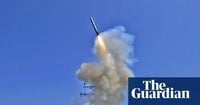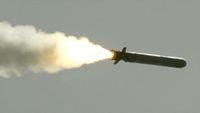On October 12, 2025, President Donald Trump issued a stark warning to Russia, declaring that he may send long-range Tomahawk missiles to Ukraine if Moscow does not move to settle the ongoing war. Speaking to reporters aboard Air Force One as he traveled to Israel, Trump’s remarks marked a sharp escalation in rhetoric—and possibly, in U.S. involvement—at a time when the conflict shows no sign of abating.
“I might say, 'Look: if this war is not going to get settled, I'm going to send them Tomahawks',” Trump told the press, as reported by the Associated Press. He emphasized the power of the weapon, describing the Tomahawk as “an incredible weapon, very offensive weapon. And honestly, Russia does not need that.” The suggestion was more than just bluster; Trump confirmed that he had discussed this possibility directly with Ukrainian President Volodymyr Zelenskyy during a call that same morning.
According to Fox News, Trump said, “They need Patriots very badly. They’d like to have Tomahawks. That’s a step up. We talked about that, so we’ll see.” The former president also stated that before making any final decision, he might first speak with Russian President Vladimir Putin: “I might speak to Russia about that, in all fairness. I told that to President Zelenskyy because Tomahawks are a new step of aggression.”
Trump’s comments come on the heels of intensified Russian attacks on Ukraine’s power grid. Over the nights leading up to October 13, Russia launched a fresh wave of strikes targeting Ukrainian energy infrastructure, an annual campaign designed to cripple the country’s resources before winter. The Associated Press reported that at least 20 people were wounded in Kyiv, and a child was killed in a separate attack in the southeast. The resulting blackouts and destruction have only heightened the urgency of Ukraine’s requests for advanced weaponry.
Ukrainian President Zelenskyy, for his part, characterized his latest conversation with Trump as “very productive.” Posting on X, Zelenskyy said their talks covered “all the aspects of the situation,” including efforts to strengthen Ukraine’s air defense, resilience, and long-range capabilities, as well as “many details” related to the energy sector. In an interview with Fox News, Zelenskyy was asked whether Trump had approved the Tomahawk missile supply. He replied, “We work on it. I’m waiting for president to yes. Of course we count on such decisions, but we will see. We will see.”
The possibility of the U.S. supplying Tomahawks—a long-range, precision-guided cruise missile capable of striking deep into Russian territory—has rattled the Kremlin. Dmitry Peskov, spokesperson for President Putin, expressed “extreme concern” over the prospect, as reported by multiple outlets. Former Russian president Dmitry Medvedev went further, warning on October 13 that such a move “could end badly for everyone, especially Trump.” Medvedev ominously noted the difficulty in distinguishing between Tomahawk missiles carrying nuclear versus conventional warheads, hinting at the risk of nuclear escalation: “How should Russia respond? Exactly!” he wrote on Telegram.
Trump’s threat comes at a time of shifting U.S.-Ukraine relations and growing frustration with Putin’s refusal to engage in direct talks with Zelenskyy. Last month, Trump made a notable pivot in his stance, announcing that he now believes Ukraine could win back all the territory lost to Russia—a significant change from his previous calls for Kyiv to make concessions in order to end the war. This shift, as reported by the Associated Press, signals a tougher line and a willingness to consider new forms of military support.
Meanwhile, the Ukrainian military continues to press its own campaign, reportedly launching drone attacks on energy infrastructure in Russian-occupied Crimea. According to Reuters, Ukrainian drones hit an oil terminal and at least two Russian electrical substations, causing significant fires and damage. These strikes, enabled in part by U.S. intelligence support, have contributed to rising energy prices in Russia, prompting Moscow to cut diesel exports and import more fuel, as detailed by the Financial Times.
The global dimensions of the conflict are also shifting. A Kyiv-based think tank recently reported that India has become the leading supplier of fuel additives for Russian fighter jets, with more than half a dozen Indian companies providing nearly half of Russia’s imported fuel additives in 2024. These compounds are critical for boosting the performance of both commercial and military aircraft, and their supply underscores the complex web of international involvement in the war.
In Washington, a senior Ukrainian delegation is scheduled to visit the United States during the week of October 13, aiming to advance talks on military aid and long-range precision strike weapons, including Tomahawks and ATACMS tactical ballistic missiles. As the diplomatic dance continues, the stakes for both Kyiv and Moscow remain extraordinarily high.
The human cost of the conflict is never far from the surface. In Ukraine, a daily ritual of remembrance has taken hold: every morning at 9 o’clock, traffic stops in Kyiv and across the country for a minute of silence to honor those killed in the war. As reported by the Associated Press, this practice has become a symbol of national unity and resilience, even as Russian attacks intensify. “This war has a price, and that price is terrible – human lives,” said Ihor Reva, deputy head of Kyiv’s military administration. “You disconnect from everyday thoughts and simply devote that minute to remembrance. That’s what I’d call it – a mindful keeping of time.”
Amid the violence, First Lady Melania Trump has taken on a humanitarian role, revealing that she has been working directly with President Putin’s team to reunite Ukrainian children kidnapped and held in Russia with their families. According to The Independent, Melania Trump announced on October 10 that eight children had been returned to Ukraine following back-channel negotiations. She described this as an “ongoing mission,” emphasizing the importance of transparent communication and the return of all children and adults who remain in captivity.
Trump’s warning about Tomahawk missiles is not without controversy at home or abroad. Critics worry that such a move could dramatically escalate the conflict and risk direct confrontation between the U.S. and Russia. Supporters argue that only a credible threat of increased military support will force Moscow to the negotiating table. As the debate rages, Trump himself remains noncommittal, telling reporters, “We may not, but we may do it. I think it’s appropriate to bring up.”
With a senior Ukrainian delegation on its way to Washington and the world watching closely, the coming weeks could prove decisive. Whether Trump’s threat is a negotiating tactic or a prelude to a major shift in U.S. policy, one thing is clear: the war in Ukraine has entered a new and perilous phase, with global repercussions that are still unfolding.



